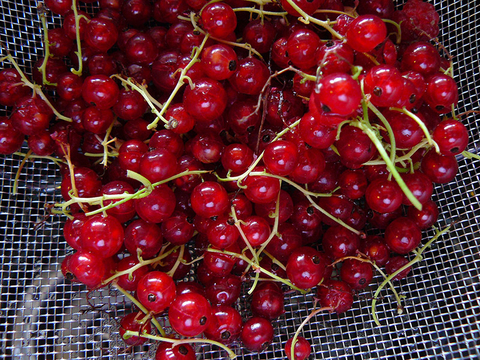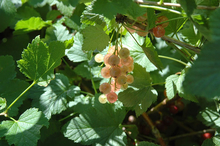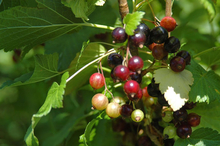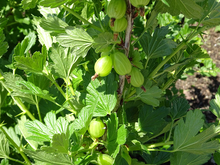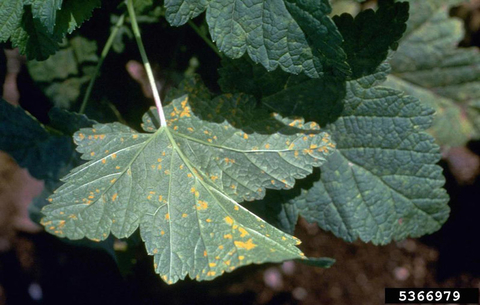Quick facts
- Currants and gooseberries will grow in full sun to partial shade. You will get more fruit if the plant is in full sun.
- Space plants at least 3 feet apart.
- Most currants and gooseberries are self-fruitful. One variety will set fruit on its own.
- Prune annually to remove weak or dead canes and to open up the canopy.
- Expect to get fruit 1 to 3 years after planting.
- Remember, gooseberry bushes are spiny and will become dense thickets without regular pruning.
Although closely related, you can easily distinguish currants and gooseberries by examining the canes and fruit.
Gooseberry canes normally produce a spine at each leaf node and bear roughly grape-sized berries singly or in groups of two or three.
Currant canes lack the spines and bear 8 to 30 pea-sized berries in clusters.
A mature currant or gooseberry shrub can produce up to four quarts of fruit annually. Most commercially available varieties have adequate winter hardiness for the Upper Midwest.
Selecting plants
Red, pink, and white currant
- Red, pink and white currants are the same species, Ribes sativum.
- Red, pink and white currants are self-fertile, meaning one plant will set fruit without any other currant varieties nearby.
- Pink and white currants are albino selections of red currant.
- The fruit of pink and white currants is generally less acidic.
- Some consider pink and white currants to be better for fresh eating.
Black currant
- The European black currant is Ribes nigrum.
- They are widely grown in Northern Europe for their high vitamin C content.
- Black currants have a strong and unusual flavor.
- They are ripe when the fruit has a deep, purple-black color.
- Some varieties are self-fertile. Those that are not self-fertile require a second variety to ensure fruit set.
Gooseberry
- Gooseberries of American origin are Ribes hirtellum or hybrids derived from this species, while the European species is Ribes uva-crispa.
- Gooseberries are self-fertile, so you will grow plenty of fruit with just one plant.
- Gooseberries have translucent skin. Depending on the variety, it might be light green, pink, or even red when ripe.
- The wilted flower that precedes the berry often hangs on throughout the season. Pluck that off before eating.
Jostaberry
- The jostaberry (pronounced yust-a-berry) is a cross of black currant and gooseberry.
- It is sweeter than gooseberry, thornless, disease-resistant, and easy to grow.
Varieties
Varieties in the tables below are recommended based on disease resistance, fruit quality, overall plant performance and availability.
Many other varieties are available, but those listed here have performed best in trials and are well suited to the home garden and landscape. The following tables are divided into red, pink, white and black currant, gooseberry and jostaberry varieties.
University of Minnesota releases are in bold and include the date of introduction.
Red currant varieties recommended for northern gardens
| Variety | Hardiness (zone 4 to zone 3) | Powdery mildew | Description |
|---|---|---|---|
| Red Lake (1933) | Excellent to very good | Susceptible | Widely available. Vigorous plants. Large, bright red berries. Good quality fruit. |
| Rovada | Excellent to very good | Resistant | Large, aromatic berries, borne in long clusters. Very reliable, as it is late to flower, avoiding frosts. |
| Honeyqueen | Excellent to very good | Resistant | Long harvest period of tender, juicy fruit with good flavor. |
Pink and white currant varieties recommended for northern gardens
| Variety | Hardiness (zone 4 to zone 3) | Powdery mildew | Description |
|---|---|---|---|
| Blanka | Excellent to very good | Resistant | Large berries have a mild, sweet flavor. Flowers late, avoiding frosts. Foliage is ornamental red and green. |
| Pink Champagne | Excellent to very good | Resistant | Pink berries have very good flavor for fresh eating, but yields can be low. Good disease resistance. |
| Primus | Excellent to very good | Susceptible | Translucent white fruit with a sweet, intense flavor. Red-tinged foliage. |
| White Imperial | Excellent to very good | Resistant | Pinkish white berries are medium sized, sweet, juicy and rich-flavored. |
Black currant varieties recommended for northern gardens
| Variety | Hardiness (zone 4 to zone 3) | Powdery mildew | Description |
|---|---|---|---|
| Ben Sarek | Excellent to very good | Susceptible | Heavy yields of large berries on compact plants. Highly resistant to white pine blister rust. Tolerates some frost during bloom. Ideal for the home garden. |
| Crandall | Excellent to very good | Susceptible | Different and milder flavor than other black currants. Vigorous, very resistant or perhaps immune to blister rust. Ornamental with clove-scented flowers in spring and brilliant fall foliage. Canes may be weak, breaking or drooping to the ground under full crops; may need trellising. |
| Crusader | Excellent to very good | Susceptible | Immune to blister rust. Large fruits of fair quality on a vigorous shrub. Not self-fertile; must be planted with another black currant variety to produce fruit. |
| Titania | Excellent to very good | Resistant | High yields of large high-quality berries are borne earlier - within three years of planting - than other varieties. Very vigorous, tall plants (to 6 feet) are immune to blister rust. Self-fertile: no other varieties need be planted to get good crops. |
Black currant-gooseberry recommended for northern gardens
| Variety | Hardiness (zone 4 to zone 3) | Powdery mildew | Description |
|---|---|---|---|
| Jostaberry | Excellent to very good | Resistant | Large, vigorous, thornless canes bear clusters of sweet berries with a hint of the characteristic black currant flavor. Hardy, heavy yielding. Resistant to white pine blister rust. |
Gooseberry varieties recommended for northern gardens
| Variety | Hardiness (zone 4 to zone 3) | Powdery mildew | Description |
|---|---|---|---|
| Captivator | Excellent to very good | Resistant | Large, sweet, reddish fruit on tall, hardy plants bearing few spines. |
| Colossal | Excellent to very good | Tolerant | Fruit are very large and deep red when fully mature. Vigorous, hardy, and tolerant of white pine blister rust. |
| Hinnomaki Red | Excellent to very good | Resistant | Sweet, flavorful berries have tart skin. Productive, moderately vigorous plants. May fruit the year of planting. |
| Invicta | Excellent to very good | Resistant | Very high yields of large green berries on vigorous, very spiny plants. Fruit has a mild flavor. Moderate resistance to blister rust. |
| Poorman | Excellent to very good | Resistant | An excellent choice for the home gardener. Large fruit has good flavor and ripens over a long harvest season. Vigorous plants have only a few small thorns. |
| Tixia™ | Excellent to very good | Resistant | Nearly thornless with large, bright red, teardrop-shaped fruit. |
| Welcome (1957) | Excellent to very good | Moderately resistant | Reddish fruit is somewhat tart. Hardy plants are vigorous once established, upright and nearly spine-free. |
Location
- If possible, prepare your planting location the autumn before you intend to plant.
- Currants and gooseberries will grow well in full sun to partial shade.
- As with any fruiting plant, partial shade might mean less vigor and smaller/fewer fruit.
- Rid the planting site of all perennial weeds, as they are much more difficult to control after planting.
Soil testing and fertilizer
- While they will tolerate marginal soil, currants and gooseberries perform best in rich, well-drained soil.
- Test your soil for pH and nutrient needs.
- Add organic material such as peat or compost according to soil test recommendations.
- A composted material rich in nitrogen, such as well-rotted manure, makes an excellent fertilizer for currants and gooseberries.
- Because composted materials release their nutrients more slowly than synthetic fertilizers, apply a few shovels-full per plant in late fall.
Planting
Bare-root and potted plants
- Plants ordered from online or mail-order sources are usually sent bare-root, while plants from a local nursery will likely be potted.
- To establish your new shrubs before the onset of hot weather, plant bare-root or potted plants in spring as soon as the soil is workable.
- Do not be afraid to plant early in the season, as even a plant that is beginning to leaf out can tolerate temperatures as low as 19°F.
- When handling bare-root plants, make certain to keep the plants cool and moist until they go into the ground.
- Do not allow the roots to dry nor become waterlogged.
- Just before planting, soak the roots of bare-root plants in a bucket of water for three to four hours.
- Plant currants and gooseberries at least an inch deeper than they were planted in the nursery, in holes deeper and wider than their root systems.
- Cover lower canes with soil to a depth of two to three buds to encourage a larger root system and the development of numerous renewal canes.
- This strategy will maximize the useful lifespan of the plant.
- Space plants as close as three feet apart.
- Black currants are more vigorous. Space them four to five feet apart.
- Currants are self-fertile, but research suggests that planting more than one variety results in better yields.
Initial pruning
After planting, prune all canes back to four to six aboveground buds. The resulting low bud count encourages the development of vigorous new canes.
Mulch
- At planting time, provide two to four inches of organic mulch such as wood chips, pine needles or compost.
- Mulching cools the soil, conserves water and suppresses weeds. These benefits are preferable in a partially shaded site, and essential in a sunny spot.
- Beginning the year after planting, renew mulch annually.
- You may need to apply extra nitrogen fertilizer if you use a low-nitrogen mulch such as wood chips or sawdust.
- Signs of nitrogen deficiency include yellowing leaves (older leaves yellow first) and poor growth.
How to keep your currants and gooseberries healthy and productive
- After planting, remove weeds regularly within the canopy of the plant.
- Grasses are especially competitive.
- Maintain a three to four inch layer of mulch to prevent weed growth.
- Insect pests are a minor concern for home growers of currants and gooseberries. Infestations are uncommon and rarely cause major damage.
- Possible insect pests include aphids, cane borers, spider mites, fruit worms and fruit flies. Other insects in the garden usually control these pests.
- Avoid damage by maintaining a healthy, vigorous plant.
- Select a site with good soil and ample light.
- Providing adequate water.
- Prune regularly.
- Remove affected or dead plant parts and plant debris.
Currants are easy to manage in the Upper Midwest, and do not require extensive measures to control diseases. Careful site selection and good cultural practices such as mulching, pruning and sanitation will minimize pest problems.
Powdery mildew
- Powdery mildew can be a problem in some years and some locations.
- Prevention is the best measure for controlling powdery mildew.
- Plant mildew-resistant varieties.
- Site plants where they will receive good air circulation and plenty of sunlight, as this will reduce spore germination.
- Regular pruning improves air circulation.
- Remove any dead plant debris from the vicinity of currant shrubs, as this material can harbor fungal spores.
- Remove affected plant parts at the first sign of powdery mildew to prevent spread to the rest of the plant.
- Dispose of plant debris in a hot compost pile or in the trash.
White pine blister rust
- Currants, gooseberries and other plants in the Ribes genus play a part in white pine blister rust (Cronartium ribicola).
- Blister rust is little more than a nuisance to the grower of currants, but can be devastating to white pine trees.
- Newer currant and gooseberry varieties have been bred with rust resistance, so the planting of these fruits is no longer a concern in the Upper Midwest region.
- Planting remains restricted in some areas of the U.S.
- When purchasing plants, choose varieties with known resistance to white pine blister rust.
- Proper pruning will improve sun penetration into the plant and maintain good air circulation to minimize disease.
- Prune established currant and gooseberry shrubs annually in late winter (early March), before new growth appears, to encourage vigor and fruit production.
- During the first three years of growth, allow four or five canes to develop per year. Remove only weak or damaged wood.
- Beginning in the fourth year, prune out the oldest wood annually. Remove any weak new growth.
- A mature shrub should have 9 to 12 canes once pruning is completed.
- Fruit is produced on one, two and three year-old wood. Try to keep three to four canes of each age.
- Always remove unwanted canes as close to the ground as possible.
- When pruning gooseberries, look for canes that are arching over with tips near the ground or lying on the ground. Prune these canes.
- Gooseberry canes can root from the tips if allowed to touch the ground.
Seasonal checklist
| Things to do | When to do them |
|---|---|
| Plant new currant and gooseberry bushes | April, May |
| During bloom, look for insect and disease symptoms | May, June |
| Watch for powdery mildew; treat or prune as needed | June through September |
| Harvest | July, August |
| Remove fallen leaves, other plant debris before snowfall | October, November |
| Apply composted manure before snowfall | October, November |
| Prune weak, dead wood; thin to open canopy before growth starts | March |
- Monitor the color and flavor of currants and gooseberries as they develop to tell when they are ripe.
- When using the fruit for jam, harvest it before it is fully ripe so natural fruit pectin levels will be higher.
- Cool fruit quickly and put it in covered containers or closed bags.
- This will maintain humidity levels and prevent drying when storing fruit in the refrigerator.
- Promptly cooled berries will keep in the refrigerator for up to several weeks.
- Fruit is delicious while fresh, right off the plant.
- Currants and gooseberries make excellent preserves and juice.
- You can use berries of all colors to make wine.
- For a nice treat in summer, freeze clusters of berries and add them to glasses of iced tea, lemonade or your favorite cocktail.
Reviewed in 2024


